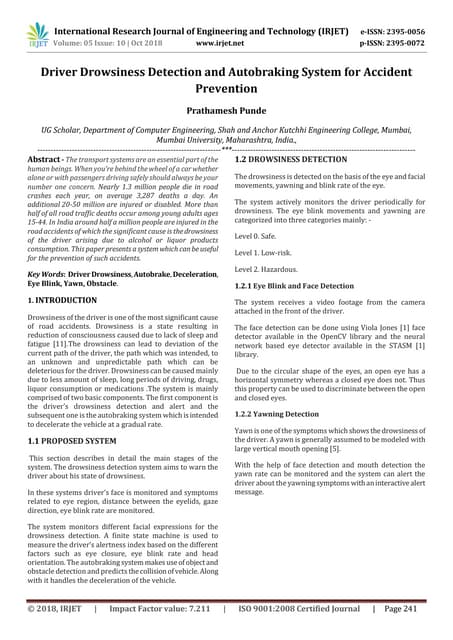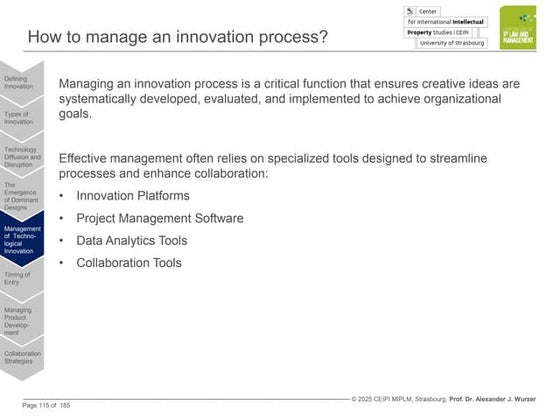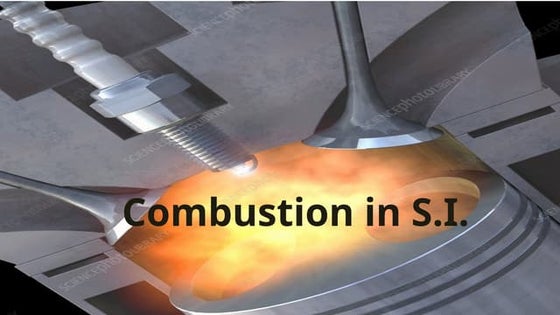firefighting robot embedded system project
- 1. ║▌║▌▀Ż # 1 of Total 15 ║▌║▌▀Żs Ashiqur Rasul Lecturer Department of EEE Southeast University Design & Implementation of Assistive Technology for Safe Driving Priyanka Sarkar ID:2021000520050 Binoy Roy ID:2021000520063 Sourav Mistry ID:2021000520044 Sudipto Raj Sikder ID:2021000520069
- 2. ║▌║▌▀Ż # 2 of Total 15 ║▌║▌▀Żs Introduction Road accident is one of the major problems in road transportation system. The aim of the project is to minimize road accident using driving assistive technologies. Road accidents occurred by different causes like road condition, over crossing, lane individuation, weather condition, less cautious activity of driver etc.This assistive technology will help driver to view object in foggy weather. It will also measure object distance for safety breaking. Driving security is ensured by this system using face recognition to avoid non authentic driving personnel. Lane detection is another important feature of this assistive system. Alcohol sensor is used to avoid driving by drunk driver. To implement safe driving thermal imaging system & AI machine vision technologies are used in this assistive system.
- 3. ║▌║▌▀Ż # 3 of Total 15 ║▌║▌▀Żs Objectives ’üČ Reduce Road Accident ’üČ Driver Visual Assistance ’üČ Safety Braking ’üČ Safety Alarms ’üČ Driving Access Security ’üČ Driver Drowsiness Detection ’üČ Lane Departure Alert ’üČ Accident Detection & Notification
- 4. ║▌║▌▀Ż # 4 of Total 15 ║▌║▌▀Żs Executive Summary Road safety is a global concern, with human errors being a primary cause of traffic accidents. This project aims to design and implement an assistive technology system to enhance driver safety and reduce accidents through advanced real-time monitoring and support systems. The system will leverage sensors, artificial intelligence, and user-friendly interfaces to assist drivers in making safer decisions while driving. Key components of the system will include real-time monitoring of driver behavior, detection of potential hazards (such as obstacles or lane departures), and fatigue detection using facial recognition and biometric sensors. Additionally, the system will feature advanced driver assistance systems (ADAS) to provide alerts for collisions, speed limit violations, and blind-spot detection. The technology will also incorporate voice commands, ensuring hands-free interaction and minimizing driver distractions. By integrating data from various sensors), the system will offer comprehensive support, especially in challenging driving conditions like poor visibility or heavy. This will contribute to reducing road accidents, improving safety for all road users, and promoting a safer driving environment.
- 5. ║▌║▌▀Ż # 5 of Total 15 ║▌║▌▀Żs Block Diagram
- 6. ║▌║▌▀Ż # 6 of Total 15 ║▌║▌▀Żs Drowsiness Detection Systems Driver drowsiness and fatigue are significant causes of road accidents. Every year, they increase the number of deaths and fatalities worldwide. A module for an advanced driver assistance system is presented in this system to reduce the number of accidents caused by driver fatigue and thus increase transportation safety; this system deals with automatic driver drowsiness detection based on visual information. Building a driver drowsiness detection system using Arduino involves using sensors and algorithms to monitor the driverŌĆÖs behavior and physiological signals. Eye blink sensor) To detect the driverŌĆÖs blinking patterns. Heart rate sensor (optional):To monitor the driverŌĆÖs heart rate for signs of fatigue.Accelerometer/Gyroscope (optional): To detect erratic vehicle movement. Camera with OpenCV (optional for advanced): For facial and eye tracking to detect signs of drowsiness.
- 7. ║▌║▌▀Ż # 7 of Total 15 ║▌║▌▀Żs Lane Departure Systems Lane Departure Warning System (LDWS) using Arduino is a simple yet effective project designed to enhance driving safety by alerting drivers when their vehicle unintentionally drifts out of its lane. This can be implemented using a combination of sensors and camera modules to detect lane markings and provide real-time feedback to the driver. The LDWS works by continuously monitoring the vehicle's position relative to the lane markings. Using a camera or line tracking sensors, the system detects if the vehicle crosses a lane without the use of turn signals. If a lane departure is detected, an alert (sound, vibration, or visual) is triggered to warn the driver. For IR sensors: If both sensors detect the lane markers, the vehicle is within the lane. If one of the sensors stops detecting a marker, the vehicle is drifting. For a camera-based system: The camera captures the road ahead, and image processing algorithms are used to detect lane lines.
- 8. ║▌║▌▀Ż # 8 of Total 15 ║▌║▌▀Żs Accident Detection Systems The system uses sensors like an accelerometer and vibration sensor to detect an accident. If a sudden change in acceleration or vibration is detected, the system determines it as an accident and sends an SMS alert containing the vehicle's GPS coordinates to pre- defined emergency contacts using the GSM module. Additionally, the system includes a manual override button to cancel false detections. Use an accelerometer or vibration sensor to detect accidents. The accelerometer tracks rapid changes in motion, while a vibration sensor detects sudden shocks or impacts.Accident Detection: Set threshold values for the accelerometer. If the G-force exceeds the threshold, the system registers it as a crash.The GSM/GPS module will provide real-time location data in case of an accident, and the GSM module will send a notification SMS with the accidentŌĆÖs location to emergency contacts. Alert Mechanism: If the system detects an accident, it activates an alarm (buzzer) and sends the GPS coordinates through SMS. Manual Override: A button can be added to cancel the emergency alert if the detection was a false positive (no real accident occurred).
- 9. ║▌║▌▀Ż # 9 of Total 15 ║▌║▌▀Żs Alcohol Detection The safety precaution comes into existence due to the inseparable habit of drinking alcohol and then driving the vehicle which is a serious offence in the eyes of law. The issue is also a serious public health problem and can arise as a important hitches in near coming days. The arrangement developed targets to lower down the risk of driving and also reduce the misfortune on road in the coming days due to drunken driver. The work done in this area uses different application of electronic sensors and microcontroller [10]. The investigation discusses the development in alcohol sensor that read a change in the alcohol particle present in the air. Such kind of detector is known as a breath analyzer , as it used to finding the analysis of the alcohol content present in human breathe. The product incorporates detector, microcontroller and other electronic components find the existence of alcohol nearby instantly block the fuel and hence the engine stop working. This activity will not permit drunken driver to run the engine and thus the arrangement enables passengers to be safe.
- 10. ║▌║▌▀Ż # 10 of Total 15 ║▌║▌▀Żs Speed Detection Systems Vehicle speed detection system using Arduino typically involves using ultrasonic sensors or IR sensors to detect the time it takes for an object to pass between two points, which can then be used to calculate the speed of the object. The basic idea is to measure the time taken by an object to pass between two sensors placed at a known distance apart. The speed is calculated using the formula: Where: Distance: The known distance between the two sensors. Time: The time taken by the object to pass between the two sensors. Sensor Functionality: Two ultrasonic sensors are used to detect the presence of an object. The time1 variable captures the moment the object crosses the first sensor. The time2 variable captures the moment the object crosses the second sensor.
- 11. ║▌║▌▀Ż # 11 of Total 15 ║▌║▌▀Żs Arduino Uno R3 ’āśThe Arduino Uno Rev3 SMD is a microcontroller board based on the ATmega328. ’āśIt has 14 digital input/output pins (of which 6 can be used as PWM outputs), 6 analog inputs, ’āśFlash Memory: 32 KB (ATmega328P ’āśClock Speed: 16 MHz ’āśLength: 68.6 mm
- 12. ║▌║▌▀Ż # 12 of Total 15 ║▌║▌▀Żs Prototype Physical View
- 13. ║▌║▌▀Ż # 13 of Total 15 ║▌║▌▀Żs ’é¦ Collision warning and automatic braking ’é¦ Adaptive front headlights ’é¦ Lane departure warning ’é¦ Lane keeping assistance ’é¦ Blind spot ’é¦ Driver monitoring ’é¦ Speed alert ’é¦ Assisted parking ’é¦ Overtaking assistance ’é¦ Signal violation warning Future Scopes
- 14. ║▌║▌▀Ż # 14 of Total 15 ║▌║▌▀Żs ’é¦ These principles cover the basic driver interface and intervention capabilities for active vehicle control systems. ’é¦ These principles may also be relevant to automation that provides information and warnings to drivers. ’é¦ These principles apply to systems that support elements of the driverŌĆÖs task. ’é¦ These principles also apply to systems that can actively change vehicle speed and direction. Scope of Control Principles
- 15. ║▌║▌▀Ż # 15 of Total 15 ║▌║▌▀Żs ’é¦ Automation should provide users with safe, comfortable, convenient and efficient mobility. ’é¦ This document describes some of the human factors issues and needs associated with driving task automation. ’é¦ It sets out some basic principles that will help to optimize system performance and avoid drivers being out-of-the-loop and unprepared to manage safety-critical situations when they are needed. ’é¦ When the advanced driver assistance systems control or support elements of the driving task, drivers should be fully aware of the performance and limitations of those functions. Conclusion
- 16. ║▌║▌▀Ż # 16 of Total 15 ║▌║▌▀Żs Thank you








![║▌║▌▀Ż # 9 of Total 15 ║▌║▌▀Żs
Alcohol Detection
The safety precaution comes into existence due to the inseparable habit of drinking alcohol and then driving the vehicle which is a
serious offence in the eyes of law. The issue is also a serious public health problem and can arise as a important hitches in near coming
days. The arrangement developed targets to lower down the risk of driving and also reduce the misfortune on road in the coming days
due to drunken driver. The work done in this area uses different application of electronic sensors and microcontroller [10]. The
investigation discusses the development in alcohol sensor that read a change in the alcohol particle present in the air. Such kind of
detector is known as a breath analyzer , as it used to finding the analysis of the alcohol content present in human breathe. The product
incorporates detector, microcontroller and other electronic components find the existence of alcohol nearby instantly block the fuel and
hence the engine stop working. This activity will not permit drunken driver to run the engine and thus the arrangement enables
passengers to be safe.](https://image.slidesharecdn.com/pptassitivetech-250110082657-9f54005e/85/firefighting-robot-embedded-system-project-9-320.jpg)






























































